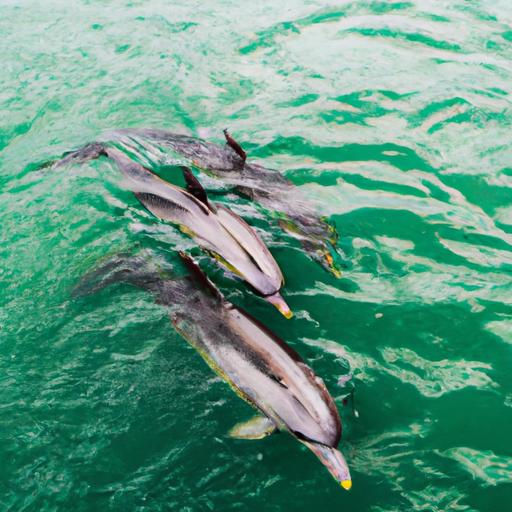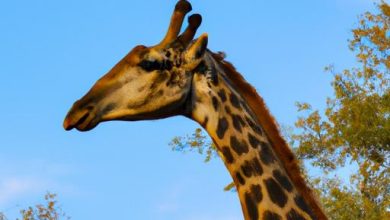How are Dolphins Mammals?

Have you ever wondered what makes dolphins such fascinating creatures? Contrary to popular belief, dolphins are not fish; they are actually mammals. Yes, that’s right – mammals! In this article, we’ll explore the intriguing world of dolphins and uncover the reasons behind their classification as mammals.
Introduction: Understanding Mammals and Dolphins
To comprehend why dolphins are considered mammals, let’s first delve into what defines a mammal. Mammals are a diverse group of animals characterized by several key features. One crucial characteristic is their warm-blooded nature, allowing them to regulate their body temperature irrespective of the environment. Unlike cold-blooded creatures, such as fish or reptiles, mammals can maintain a constant internal temperature, enabling them to thrive in various habitats.
Dolphins, with their sleek and graceful bodies, are a perfect example of mammals adapted to life in the aquatic realm. Despite their appearance, they share numerous similarities with other mammals on land. For instance, mammals possess mammary glands, allowing them to nurse their young with milk. Similarly, dolphins nurse their calves with nutrient-rich milk produced by specialized mammary glands.
Furthermore, just like most mammals, dolphins give birth to live young ones. This means that baby dolphins, or calves, develop within their mothers’ bodies before being born, rather than hatching from eggs like fish or reptiles. Once born, the mother dolphins provide devoted care and nurture their offspring, ensuring their survival and growth.
Another fascinating aspect is the presence of hair or fur on the bodies of mammals. While dolphins do not possess hair all over their bodies, they do have a few bristles around their snouts during the early stages of development, which eventually disappear. This hair-like feature is a significant characteristic shared by mammals, including dolphins.
In conclusion, dolphins indeed fall under the category of mammals due to their warm-blooded nature, possession of mammary glands for nursing, live birth, and the presence of hair during their early stages. Now that we’ve established their mammalian nature, let’s dive deeper into the anatomy, evolutionary history, and unique attributes of these incredible marine mammals. Stay tuned for the upcoming sections where we explore the fascinating world of dolphins!
Mammalian Features of Dolphins
Dolphins, despite their aquatic lifestyle, possess distinct mammalian characteristics that set them apart from other marine creatures. Let’s explore these unique features in detail:
Warm-Blooded Nature and Temperature Regulation
One of the defining traits of mammals, including dolphins, is their warm-blooded nature. Unlike cold-blooded creatures that rely on the surrounding environment to regulate their body temperature, dolphins possess the remarkable ability to maintain a consistent internal temperature, regardless of their surroundings. This enables them to thrive in a wide range of aquatic environments, from the chilly waters of the Arctic to the tropical seas.
Mammary Glands and Milk Production
Mammals are known for their ability to produce milk to nourish their young, and dolphins are no exception. Female dolphins possess mammary glands, which produce nutrient-rich milk to feed their calves. This ensures that the young dolphins receive the necessary nourishment and energy for growth and development during their early stages of life.
Live Birth and Nurturing of Young Ones
Unlike fish or reptiles that lay eggs, dolphins give birth to live young ones. Female dolphins carry their developing offspring within their bodies until the time of birth. Once the calves are born, the mother dolphins provide dedicated care and protection, guiding them through their early stages of life. This nurturing behavior is a common trait among mammals, showcasing the strong maternal instincts of dolphins.
Possession of Hair or Fur
While dolphins may not be covered in hair or fur like some other mammals, they do exhibit a unique feature during their early stages of development. Young dolphins have a few bristles around their snouts, which resemble short hairs. Although these bristles eventually disappear as the dolphins grow older, they signify the presence of hair-like structures, further solidifying their classification as mammals.
In summary, dolphins possess key mammalian features, including their warm-blooded nature, mammary glands for milk production, live birth, and the presence of hair-like structures during their early stages. These characteristics highlight the remarkable similarities between dolphins and other mammals, proving that these captivating marine creatures are indeed an integral part of the mammalian family. Stay tuned as we delve deeper into the fascinating anatomy and physiology of dolphins in the upcoming sections!
Anatomy and Physiology of Dolphins
When it comes to the anatomy and physiology of dolphins, there are several intriguing aspects to explore. Let’s take a closer look at how their body structure resembles other mammals and the unique physical adaptations that allow them to thrive in their watery habitat.
Resemblance to Other Mammals
At first glance, dolphins may seem vastly different from land-dwelling mammals. However, upon closer inspection, we discover that their body structure shares many similarities with their terrestrial counterparts. Dolphins have streamlined bodies with a distinct head, torso, and tail. This basic body plan is reminiscent of other mammals, highlighting their common ancestry.
Adaptations for Living in Water
Dolphins have undergone remarkable adaptations to suit their aquatic lifestyle. Their bodies are perfectly streamlined to minimize resistance as they glide effortlessly through the water. The absence of hind limbs, replaced by powerful tails, allows for efficient propulsion and agile maneuverability.
One of the most fascinating adaptations of dolphins is their specialized respiratory system. Unlike land mammals that breathe through their noses, dolphins respire through a blowhole located on the top of their heads. This unique feature enables them to breathe quickly and efficiently while maintaining their streamlined shape in the water.
Holding Breath and Diving Abilities
Dolphins possess an astounding ability to hold their breath for extended periods. This skill is crucial for their survival as they dive deep into the ocean in search of food. While the duration varies among species, some dolphins can hold their breath for up to 15 minutes before resurfacing. Their lungs are specially adapted to store large amounts of oxygen, facilitating these impressive diving feats.
Additionally, dolphins have evolved a remarkable blood circulation system that redirects blood flow during deep dives. This mechanism helps conserve oxygen and ensures that vital organs receive sufficient oxygen even in oxygen-deprived conditions.
In summary, the anatomy and physiology of dolphins exhibit both resemblances to other mammals and unique adaptations for their aquatic lifestyle. Their streamlined bodies, specialized respiratory system with blowholes, and exceptional diving abilities all contribute to their remarkable survival in the vast ocean. In the next section, we will explore the evolutionary history of dolphins as mammals and unravel their fascinating origins. Stay tuned for more intriguing insights into these captivating marine creatures!
Evolutionary History of Dolphins as Mammals
Evolutionary Origins and Relationships with Other Mammals
Dolphins, with their graceful movements and remarkable intelligence, have a rich evolutionary history that dates back millions of years. These fascinating creatures are believed to have evolved from land-dwelling mammals that gradually adapted to life in water. Scientists speculate that the ancestors of dolphins were terrestrial animals that ventured into the oceans in search of food or to escape predators.
Through extensive research, it has been discovered that dolphins are closely related to other marine mammals, such as whales and porpoises. These aquatic mammals belong to the order Cetacea, which is further divided into two main suborders: Odontoceti (toothed whales, including dolphins) and Mysticeti (baleen whales). This classification reflects the shared evolutionary history and distinct characteristics of these magnificent creatures.
Fossil Evidence and Transitional Forms
The fossil record plays a crucial role in unraveling the evolutionary journey of dolphins as mammals. Numerous fossil discoveries have provided valuable insights into their ancestral lineage and the transitional forms that emerged over time. Fossils of early dolphins, known as archaeocetes, showcase a remarkable transformation from land-dwelling mammals to fully aquatic beings.
Transitional forms, such as the famous Ambulocetus and Basilosaurus, provide evidence of the gradual adaptation to an aquatic lifestyle. These ancient creatures possessed features that bridged the gap between land and sea, displaying a combination of terrestrial and marine adaptations. The fossils of these transitional forms not only shed light on the evolutionary process but also highlight the incredible diversity within the lineage of dolphins.
Adaptations for Aquatic Life over Millions of Years
Over the course of millions of years, dolphins have undergone remarkable adaptations to thrive in their marine environment. Their streamlined bodies, streamlined snouts, and elongated tails enable them to move swiftly through the water. In addition, their forelimbs have evolved into powerful flippers that aid in steering and maneuvering underwater.
Dolphins have also developed a specialized respiratory system that allows them to remain submerged for extended periods. They possess a blowhole on top of their heads, enabling them to take quick breaths at the water’s surface. When diving, these intelligent mammals can close their blowhole, preventing water from entering their airways.
In conclusion, the evolutionary history of dolphins as mammals is a captivating tale of adaptation and transformation. Through fossil evidence and the study of transitional forms, scientists have unraveled the origins and relationships of these marine mammals. Their remarkable adaptations for aquatic life over millions of years have shaped them into the graceful and intelligent creatures we marvel at today. In the next section, we will explore the similarities and differences between dolphins and other mammals, both on land and in the sea.
Similarities and Differences with Other Mammals
When it comes to comparing dolphins with other mammals, both on land and in the sea, intriguing similarities and distinctive features emerge. Let’s explore these comparisons and discover what sets dolphins apart from their fellow mammals.
Comparisons with Land Mammals
While dolphins have adapted to an aquatic lifestyle, they still share several characteristics with their terrestrial counterparts. Like land mammals, dolphins have lungs and breathe air. They possess a diaphragm, allowing them to take in oxygen and release carbon dioxide through respiration. This fundamental similarity with land mammals enables dolphins to surface and take deep breaths before diving back into the water.
Moreover, dolphins, like land mammals, possess a sophisticated skeletal structure that includes a backbone, ribs, and a skull. These components provide support and protection for vital organs, ensuring the overall structural integrity of their bodies. The resemblance between the skeletal systems of dolphins and land mammals showcases the evolutionary connections between these distinct groups.
Distinctive Features and Behaviors
Dolphins possess distinctive features and behaviors that set them apart from other mammals. One of the most remarkable features is their streamlined bodies, specifically adapted for efficient movement through water. Their sleek shape, paired with powerful muscles, allows them to swim swiftly and gracefully, effortlessly cutting through the waves.
Additionally, dolphins are renowned for their intelligence and social behavior. They exhibit complex communication systems, using clicks, whistles, and body language to interact with each other. These social interactions often involve cooperative hunting, intricate mating rituals, and the formation of close-knit family groups known as pods. Such social behaviors are unique to dolphins and contribute to their reputation as highly intelligent and sociable creatures.
Shared Characteristics with Other Marine Mammals
Dolphins are not the only marine mammals inhabiting the oceans. They share certain characteristics with other marine mammals, such as whales and seals. For instance, like dolphins, these marine mammals are warm-blooded, possess mammary glands for nursing, and give birth to live young ones. Additionally, all these marine mammals have evolved specific adaptations to thrive in the marine environment, including streamlined bodies, a layer of blubber for insulation, and specialized respiratory systems to facilitate prolonged dives.
In conclusion, while dolphins share similarities with both land mammals and other marine mammals, their distinctive features and behaviors make them truly unique. Their streamlined bodies, remarkable intelligence, and complex social behavior set them apart from other mammals and contribute to their allure. In the next section, we will delve into the evolutionary history of dolphins as mammals, exploring their origins and adaptations over millions of years. Stay tuned for more fascinating insights into the world of dolphins!
Conclusion
In conclusion, dolphins are captivating creatures that defy the conventional expectations of what constitutes a mammal. We have explored the defining characteristics of mammals and how dolphins align with these traits. From their warm-blooded nature and ability to regulate their body temperature to their possession of mammary glands for nursing and the nurturing of their young, dolphins exhibit all the hallmarks of being mammals.
Through their evolutionary journey, dolphins have adapted to the aquatic environment, developing unique physical features and behaviors that set them apart from other mammals. Their streamlined bodies, specialized respiratory system, and incredible ability to hold their breath underwater showcase the remarkable adaptations that have allowed them to thrive in the ocean.
Understanding dolphins as mammals is not only a fascinating aspect of our natural world but also crucial for conservation efforts. Recognizing their mammalian nature reinforces the need to protect their habitats, ensure their well-being, and preserve the delicate balance of marine ecosystems.
As we conclude this exploration of dolphins as mammals, let us appreciate the wonders of these intelligent and graceful creatures. By spreading awareness and knowledge about their unique characteristics, we can contribute to the conservation and appreciation of dolphins and the marine environments they call home.
Thank you for joining me on this journey to unravel the mystery behind how dolphins are mammals. If you’d like to learn more about these incredible creatures and other fascinating topics related to our natural world, stay tuned to vegetable.kenhtech.com for more captivating articles.
Remember, it is our collective responsibility to protect and preserve the diverse and magnificent creatures that share our planet. Together, let’s make a difference for the future of dolphins and all living beings.
Conclusion: So above is the How are Dolphins Mammals? article. Hopefully with this article you can help you in life, always follow and read our good articles on the website: vegetable.kenhtech.com


